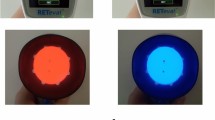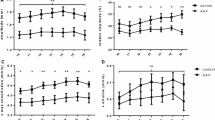Abstract
The relationship between dynamic pupillary function and peripheral nerve function was studied in 85 randomlyselected diabetic patients and 67 age-matched normals using a portable infrared pupillometer (Pupilscan Version 5). Seven measurements were chosen to represent different components of the pupillary constriction-redilatation curve after a standardized light stimulus. Constriction latency was significantly prolonged in diabetic patients (p = 0.05), as was time to 63% redilatation (p = 0.001). Thermal thresholds at the feet weakly correlated with relative reflex amplitude (warm:r = −0.22,p = 0.05; cool:r = −0.23,p = 0.05), but vibration perception thresholds were more strongly associated with constriction and redilatation velocity (r = −0.42,p = 0.001;r = −0.28,p = 0.03). Among the cardiovascular autonomic function tests, only respiratory R—R variation correlated with constriction velocity (r = 0.47,p < 0.001), and Valsalva ratio with redilatation velocity (r = 0.25,p = 0.04), but postural systolic blood pressure change was also correlated with reflex amplitude and latency time (r = −0.42,p < 0.001;r = 0.41,p = 0.001). There were no significant associations with three measures of sweating function in the feet. Pupil measurements were abnormal in 4–11% of diabetic patients, while other neurological tests were abnormal in 8–35%, consistent with the length-dependence of diabetic neuropathy. Median coefficients of variation were 2.0–7.2% in diabetic patients. Portable pupillometry using this device is currently the simplest method available for measuring a cranial autonomic pathway, though the measurements obtained with it are only weakly associated with the results of other tests of somatic and autonomic function in diabetes, and are unrelated to measurements of distal sudomotor function.
Similar content being viewed by others
References
Jordan WR. Neuritic manifestations in diabetes mellitus.Arch Int Med 1936;57: 307–366.
Rundles RW. Diabetic neuropathy.Medicine 1945;24: 111–160.
Smith SA, Dewhirst RR. A simple diagnostic test for pupillary abnormality in diabetic autonomic neuropathy.Diabetic Med 1986;3: 38–41.
Neil HAW, Smith SA. A simple clinical test of pupillary autonomic function: correlation with cardiac autonomic function tests in diabetes.Neuro-ophthalmology 1989;9: 237–242.
Hayashi M, Ishikawa S. Pharmacology of pupillary responses in diabetics—correlative study of the responses and grade of retinopathy.Jpn J Ophthalmol 1979;23: 65–72.
Hreidarsson AB. Pupil size in insulin-dependent diabetes: relationship to duration, metabolic control, and long-term manifestations.Diabetes 1982;31: 442–448.
Hreidarsson AB, Gundersen HJG. The pupillary response to light in Type 1 (insulin-dependent) diabetes.Diabetologia 1985;28: 815–821.
Lanting P, Heimans JJ, Reulen JPH, Nauta J, van der Veen EA. Pupillary light reflex and quantitative sensory and motor neural function tests in diabetic patients.J Neurol 1988;235: 245–247.
Lowenstein O, Loewenfeld IE. Mutual role of sympathetic and parasympathetic in shaping of the pupillary reflex to light.Arch Neurol Psychiat 1950;64: 341–377.
Pfeifer MA, Weinberg CR, Cook DL, Reenan A, Halter JB, Ensinck JW, Porte D. Autonomic neural dysfunction in recently diagnosed diabetic subjects.Diabetes Care 1984;7: 447–453.
Levy D, Abraham R, Reid G. A comparison of two methods for measuring thermal thresholds in diabetic neuropathy.J Neurol Neurosurg Psych 1989;52: 1072–1077.
Ewing DJ, Clarke BF. Autonomic neuropathy: its diagnosis and prognosis.Clin Endocrinol Metab 1986;15: 855–888.
Levy DM, Reid G, Abraham RR, Rowley DA. Assessment of basal and stimulated sweating in diabetes using a direct-reading computerized sudorometer.Diabetic Med 1991;8 (symposium): S78-S81.
Levy DM, Rowley DA, Abraham RR. Changes in cholinergic sweat gland activation in diabetic neuropathy identified by computerised sweatspot analysis.Diabetologia 1991;34: 807–812.
Shahani BT, Halperin JJ, Boulu P, Cohen J. Sympathetic skin response—a method of assessing unmyelinated axon dysfunction in peripheral neuropathies.J Neurol Neurosurg Psych 1984;47: 536–542.
Levy DM, Rowley DA, Reid G, Abraham RR. Quantitative measures of sympathetic skin response in diabetes: relation to sudomotor and neurological function.J Neurol Neurosurg Psych 1992;55: 902–908.
Peterson HR, Rothschild M, Weinberg CR, Fell RD, Mcleish KR, Pfeifer MA. Body fat and the activity of the autonomic nervous system.N Engl J Med 1988;318: 1077–1083.
Schumer M, Miller-Crain G, Pfeifer MA, The Statil Study Group. Diabetic autonomic neuropathy—Part II. Coefficient of variation of RR-interval and Valsalva maneuver tests.Am J Med 1988;85 (suppl 5A): 144–146.
de Vos A, Marcus JT, Reulen JP, Peters HF, Heimans J, van der Veen EA. The pupillary light reflex in diabetes mellitus: evaluation of a newly developed infrared light reflection method.Diabetes Res 1989;10: 191–195.
Levy DM, Abraham RR, Abraham RM. Small- and large-fiber involvement in early diabetic neuropathy: a study with the medial plantar response and sensory thresholds.Diabetes Care 1987;10: 441–447.
Ryder REJ, Marshall R, Johnson K, Ryder AP, Owens DR, Hayes TM. Acetylcholine sweatspot test for autonomic denervation.Lancet 1988;i: 1303–1305.
Heller PH, Perry F, Jewett DL, Levine JD. Autonomic components of the human pupillary light reflex.Invest Ophthalmol Vis Sci 1990;31: 156–162.
Lanting P, Strijers RLM, Bos JE, Faes TJC, Heimans JJ. The cause of increased pupillary light reflex latencies in diabetic patients: the relationship between pupillary light reflex and visual evoked potential latencies.Electroencephalogr Clin Neurophysiol 1991;78: 111–115.
Author information
Authors and Affiliations
Rights and permissions
About this article
Cite this article
Levy, D.M., Rowley, D.A. & Abraham, R.R. Portable infrared pupillometry using Pupilscan: Relation to somatic and autonomic nerve function in diabetes mellitus. Clinical Autonomic Research 2, 335–341 (1992). https://doi.org/10.1007/BF01824304
Received:
Accepted:
Issue Date:
DOI: https://doi.org/10.1007/BF01824304




